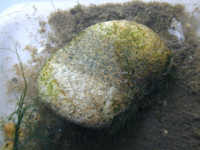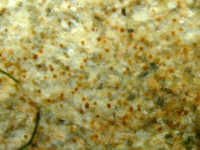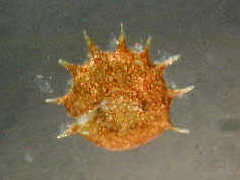
Amoebae that build their tests or shells (two species?)

Amoebae that build their tests or shells (two species?)

 I found many brown 'dots' on the surface of a small stone in a water tank.
I understand they are testate amoebae with microscope (top.)
I found many brown 'dots' on the surface of a small stone in a water tank.
I understand they are testate amoebae with microscope (top.)
Amoeba is a single cell, amorphous, well known protozoa. I think people know the name 'Amoeba', apart from wether they have seen the animal or not.
Some kinds of amoeba build a shell (or tests) in which they live. These amoeba are called testate amoeba.
You may think like this;
'If they are amoebae, they must move! Really?'
Please click on the button 'Go!' to view a time-lapse video of the testate amoeba moving. The video is a series of pictures taken over a 90 minute period. (18 frames with 5 minute intervals, 195KB ca.)
(JavaScript 1.1 is required. And some web browser requires Automatically load images.)
You may notice the pseudopod (for example, the arrowed one in the last frame.)
I made a note on testate amoeba. You should know the following is made by an amateur not by experts.
First of all, there are two kind of testate amoebae. That is,
The difference between them is the shape of pseudopod. That is, sharp pointed or not. In short, amoeba in a wide sense (phylum RHIZOPODEA) is classified by the shape of the pseudopod first. They live in a shell or not is the second.
So called amoeba have leaf-shaped pseudopod (class Lobosea.) Many testate amoebae belong to this class. I think my specimen is Arcella sp. But they have spikes...??? see the note on 15-AUG-2000
Additional information; Water bears (Tardigrada) are attacked by amoeba, especially Difflugia sp. which have shells too.
A Japanese amateur Mr Dorooi-Mizinko gave me an e-mail. He works on freshwater plankton very actively. He told me that this specimen is not Arcella, but Centropyxis sp.(probably C. aculeata.) The following is the main point of his comment.
References: http://taxa.soken.ac.jp/WWW/PDB/PCD1478/C/32.jpg
You can find the mesh pattern on the shell. This picture is deposited in Protist Information Server.
 I took the lefthand picture before.
A Japanese expert identifed this as Centropyxis aculeata.
(He told me that the number of spikes are not constant.)
The illumination make the difference from the top photograph, I think.
I took the lefthand picture before.
A Japanese expert identifed this as Centropyxis aculeata.
(He told me that the number of spikes are not constant.)
The illumination make the difference from the top photograph, I think.
Mr Dorooi-mizinko gave me commnet about the difference between ARCELLINIDA and GROMIIDA too. He pointed out that, in most cases, we can distinguish them by their shells alone (genus Pseudodifflugia is difficult)
And his advise helped me to solve the problem on the page of "Onion shaped objects". It was not the shell of amoeba but "pycnidia" of fungi. I'm very grateful for his kindness.